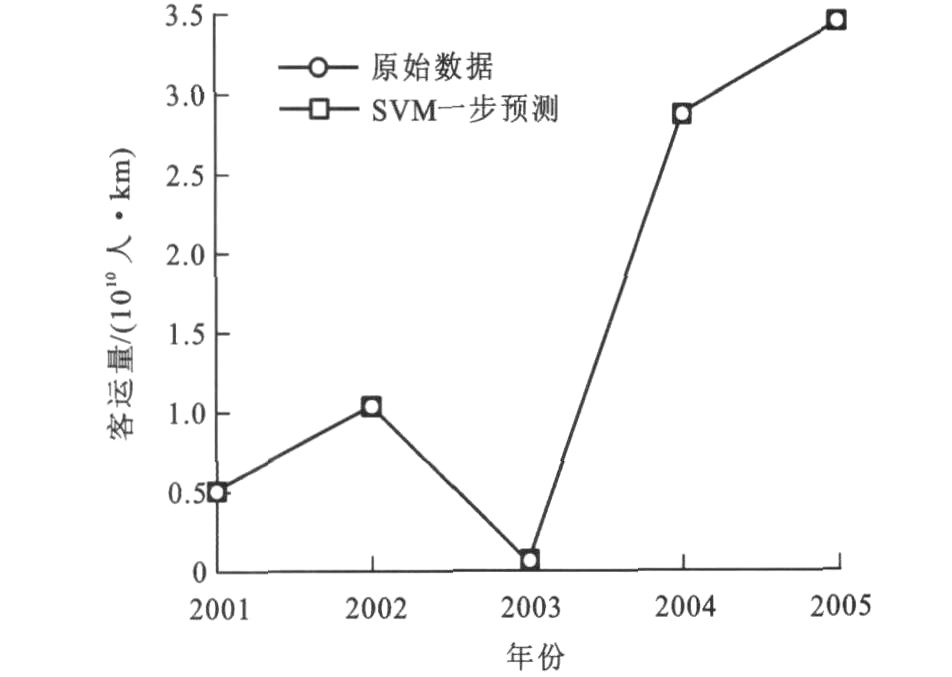Prediction model of passenger transport volume in metropolitan region based on support vector machine
Article Text (Baidu Translation)
-
摘要: 将都市圈客运量样本数据集分为训练集、测试集和检验集, 采用最小最终误差预测准则确定预测值的损失函数参数与惩罚因子, 选取ε-不敏感损失函数与高斯核函数减小预测复杂性, 构建了基于支持向量机的都市圈客运量预测模型, 并通过逐渐改变损失函数、惩罚因子与高斯核函数参数的取值, 对京津冀都市圈客运量进行了预测。预测结果表明: 客运量预测的平均相对误差为0.15%, 预测值与实测数据拟合良好, 整体变化趋势一致, 反映了预测模型的可靠性。Abstract: The sample data set of metropolitan region's passenger transport volume was divided into training set, testing set and examining set, the loss function's parameters and penalty factor were determined according to the final prediction error criterion, the ε-insensitive loss function and the Gaussian kernel function were chosen to decrease prediction complexity, and a prediction model of metropolitan region's passenger transport volume was proposed based on support vector machine. The passenger transport volume of Beijing-Tianjin-Hebei Metropolitan Region was predicted by gradual changing the parameter values of loss function, penalty factor and Gaussian kernel function. Prediction result shows that the average relative error is 0.15%, and the total changing trends of prediction value and testing value are same, so the model is credible.
-
表 1 不同参数取值时单步预测的平均相对误差
Table 1. Average relative errors of single-step prediction with different parameters
序号 C ε σ2 实际值/ (108人·km) 预测值/ (108人·km) 平均相对误差 1 10 0.000 1 3.5 1 362 1 380.074 0.013 27 2 100 0.000 1 3.5 1 362 1 362.204 0.000 15 3 1 000 0.000 1 3.5 1 362 1 362.212 0.000 15 4 10 000 0.000 1 3.5 1 362 1 362.208 0.000 15 5 100 0.010 0 1.5 1 362 1 344.321 0.012 98 6 100 0.001 0 1.5 1 362 1 359.807 0.001 61 7 100 0.000 5 1.5 1 362 1 363.076 0.000 79 8 100 0.000 1 1.5 1 362 1 362.218 0.000 16 9 100 0.000 1 0.5 1 362 1 362.216 0.000 16 10 100 0.000 1 2.0 1 362 1 362.240 0.000 16 11 100 0.000 1 3.0 1 362 1 362.218 0.000 16 12 100 0.000 1 4.0 1 362 1 362.926 0.000 68 13 100 0.000 1 4.5 1 362 1 361.115 0.001 65 14 100 0.000 1 5.0 1 362 1 357.655 0.003 19 -
[1] 马国霞, 田玉军, 石勇. 京津冀都市圈经济增长的空间极化及其模拟研究[J]. 经济地理, 2010, 30 (2): 177-182. https://www.cnki.com.cn/Article/CJFDTOTAL-JJDL201002001.htmMA Guo-xia, TI AN Yu-jun, SHI Yong. Research on spatialpolarization and si mulation of economic growth in Beijing-Tianjin-Hebei Metropolitan Region[J]. Economic Geog-raphy, 2010, 30 (2): 177-182. (in Chinese) https://www.cnki.com.cn/Article/CJFDTOTAL-JJDL201002001.htm [2] 陈洁, 陆锋. 京津冀都市圈城市区位与交通可达性评价[J]. 地理与地理信息科学, 2008, 24 (2): 53-56. https://www.cnki.com.cn/Article/CJFDTOTAL-DLGT200802015.htmCHEN Jie, LU Feng. Location advantage and accessibility evaluation on Beijing-Tianjin-Hebei Metropolitan Area[J]. Geography and Geo-Information Science, 2008, 24 (2): 53-56. (in Chinese) https://www.cnki.com.cn/Article/CJFDTOTAL-DLGT200802015.htm [3] 周伟, 王颖. 高速公路诱增交通量分析[J]. 长安大学学报: 自然科学版, 2002, 22 (1): 49-52. https://www.cnki.com.cn/Article/CJFDTOTAL-XAGL200201013.htmZHOU Wei, WANG Ying. Analysis for induced trafficvolume on expressway[J]. Journal of Chang an University: Natural Science Edition, 2002, 22 (1): 49-52. (in Chinese) https://www.cnki.com.cn/Article/CJFDTOTAL-XAGL200201013.htm [4] 王利彬, 吴群琪. 公路投资对国民经济贡献的探讨[J]. 中国公路学报, 2006, 19 (3): 96-99. https://www.cnki.com.cn/Article/CJFDTOTAL-ZGGL200603017.htmWANG Li-bin, WU Qun-qi. Discussion on contribution of highwayinvest ment to national economy[J]. China Journal ofHighway and Transport, 2006, 19 (3): 96-99. (in Chinese) https://www.cnki.com.cn/Article/CJFDTOTAL-ZGGL200603017.htm [5] 芮少权, 匡安乐. 高速公路月度交通量ARI MA预测模型[J]. 长安大学学报: 自然科学版, 2010, 30 (4): 82-85, 91. https://www.cnki.com.cn/Article/CJFDTOTAL-XAGL201004018.htmRUI Shao-quan, KUANG An-le. ARI MA model of express-way traffic volume monthly forecasting[J]. Journal ofChang an University: Natural Science Edition, 2010, 30 (4): 82-85, 91. (in Chinese) https://www.cnki.com.cn/Article/CJFDTOTAL-XAGL201004018.htm [6] 陈建安, 郭大伟, 徐乃平, 等. 遗传算法理论研究综述[J]. 西安电子科技大学学报, 1998, 25 (3): 363-368. https://www.cnki.com.cn/Article/CJFDTOTAL-XDKD803.022.htmCHENJian-an, GUO Da-wei, XU Nai-ping, et al. Areviewon the theory for the genetic algorithm[J]. Journal of XidianUniversity, 1998, 25 (3): 363-368. (in Chinese) https://www.cnki.com.cn/Article/CJFDTOTAL-XDKD803.022.htm [7] 汪传旭, 蒋良奎. 基于混合轴-辐结构的区域运输网络优化模糊交互规划模型[J]. 中国公路学报, 2010, 23 (2): 84-91. https://www.cnki.com.cn/Article/CJFDTOTAL-ZGGL201002015.htmWANG Chuan-xu, JI ANG Liang-kui. Interactive fuzzy pro-gramming model for opti mization of extended hub-and-spoke regional transportation networks[J]. China Journal of High-way and Transport, 2010, 23 (2): 84-91. (in Chinese) https://www.cnki.com.cn/Article/CJFDTOTAL-ZGGL201002015.htm [8] 袁长伟, 吴群琪. 双核都市圈运输通道旅客分担率模型及应用[J]. 长安大学学报: 自然科学版, 2007, 27 (6): 80-83. https://www.cnki.com.cn/Article/CJFDTOTAL-XAGL200706017.htmYUAN Chang-wei, WU Qun-qi. Model of passenger travel shares ratein dual-nuclei metropolis transportation corridorr[J]. Journal of Chang an University: Natural Science Edition, 2007, 27 (6): 80-83. (in Chinese) https://www.cnki.com.cn/Article/CJFDTOTAL-XAGL200706017.htm [9] 张文峰, 张小花, 曾涛. 基于模型优选及融合的高教园区出行生成预测方法[J]. 交通运输工程学报, 2010, 10 (1): 66-71. http://transport.chd.edu.cn/article/id/201002020ZHANG Wen-feng, ZHANG Xiao-hua, ZENG Tao. Forecasting method of trip generation for higher education zone based onmodel selection and integration[J]. Journal of Traffic andTransportation Engineering, 2010, 10 (1): 66-71. (in Chinese) http://transport.chd.edu.cn/article/id/201002020 [10] 徐红敏, 王海英, 梁瑾, 等. 支持向量机回归算法及其应用[J]. 北京石油化工学院学报, 2010, 18 (1): 62-66. https://www.cnki.com.cn/Article/CJFDTOTAL-BJSY201001017.htmXU Hong-min, WANG Hai-ying, LI ANGJin, et al. Supportvector machine regression algorithm and its application[J]. Journal of Beijing Institute of Petro-chemical Technology, 2010, 18 (1): 62-66. (in Chinese) https://www.cnki.com.cn/Article/CJFDTOTAL-BJSY201001017.htm -





 下载:
下载:




